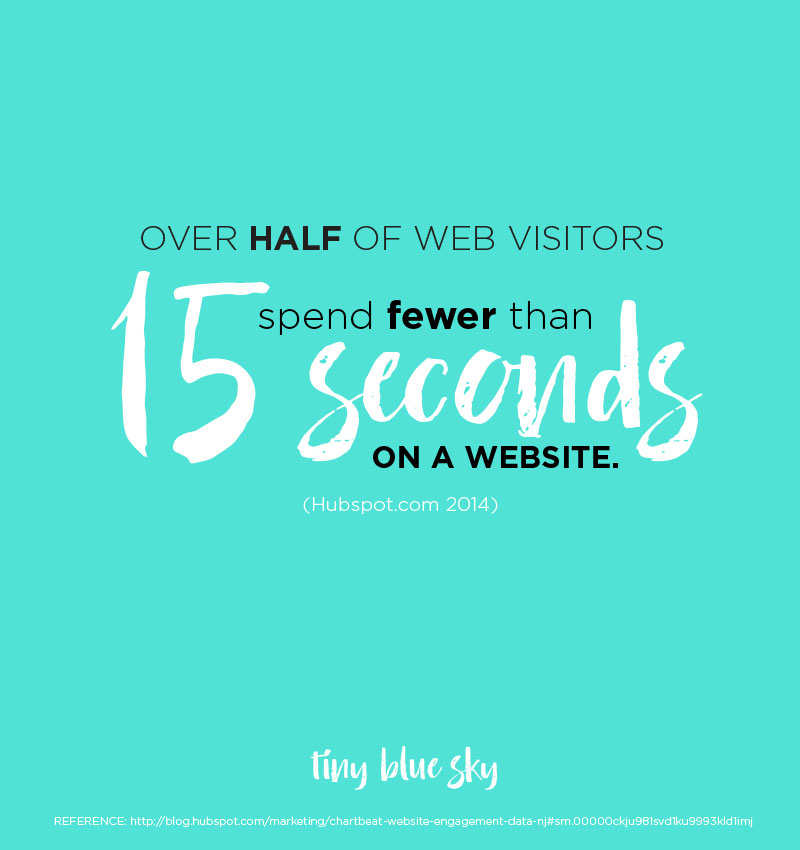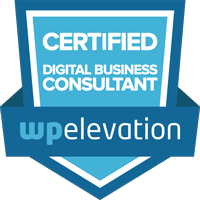Website First Impressions Matter: Why People Leave Your Website and How to Keep Them!
You only get one chance to make a good first impression – especially when it comes to your website. Over half of visitors spend fewer than 15 seconds on your website*.
If you only had 15 seconds to have a conversation with somebody about your business, what would you tell them? What would you want them to know? What do you want them to feel? All of this needs to be communicated in the first 15 seconds that a customer visits your site.

Your website needs to affirm that your potential customer is in the right place, communicate what your business is and why it matters to them, express a feeling and vibe of the brand that resonates with the potential customer, and finally, help them quickly navigate to a next step. Phew!
That’s a lot. You have no wiggle room for mistakes or bad first impressions, especially with the sea of other websites your customers can resort to if they don’t like yours. Your competitors are only a click away.
In this post, we’ll be sharing reasons that potential customers are leaving your website and how you can remedy them.
[ 1 ] THEY CAN'T FIND WHAT THEY NEED.
Deeper Problem:
Bad navigation and site structure.
People are busy. If your website’s navigation is confusion or overwhelming, a potential customer will not take the time to figure out how to navigate your site and instead they will find a website that is easier to follow, which could be the site of a competitor. After all, they have no loyalty to your company and know that there are a dozen other sites they can go to to find what they are looking for.
How to fix it:
Rethink your site structure and navigation from the USER perspective.
It sounds simple, but all too often when businesses build a website they structure their website content and its navigation to mimic how THEY run the business, something that their typical customer will be able to follow. They use internal speak and jargon in their navigation and organize their content like they do their business structure. The problem with this approach is that their potential customer could care less about business structure, they just want to find what they need. They want the site to be logical, intuitive and easy to use. Don’t make them work. When designing the structure of the site, do it from the shoes of your potential customer.
[ 2 ] THEY CAN'T TELL WHAT YOUR BUSINESS IS ABOUT.
Deeper Problem:
Bad messaging.
Your potential customer arrives on your site. When they get there they scan the site and cannot for the love of all things good, figure out what your company even does. Your site has paragraphs of flowery, vague language filled with the latest buzzwords (a committee or marketing agency spent a year perfecting this language). What the messaging doesn’t do is tell a potential customer what your company does in the simplest terms.
How to fix it:
Keep it simple.
Save the flowery messaging for deeper pages on your site. Your homepage copy needs to immediately confirm to a customer that they are on the right website. They want to know who you are, what you do and why it matters to them, in the simplest terms. From there, allow them to click around and uncover the pages jam-packed full of more creative messaging. Don’t overwhelm them at first site. Let them decide what they want more information about.
[ 3 ] THEY GET THE WRONG VIBE.
Deeper Problem:
Bad branding.
The customer arrives to your website and it looks cheap and outdated. The customer immediately begins to question the quality of the product, the security of the website and the reliability of the business. At that point, it doesn’t matter if your product is the best thing since sliced bread, you have already lost the customer into the world of poorly designed websites. If your website doesn’t communicate the quality, trustworthiness, and overall vibe of your product, you are at a huge disadvantage.
How to fix it:
Invest in design.
Invest in good design. Hire a web designer or a design company. These professionals know exactly how to direct your potential customers to the most important information first and they know how to do it in a way that keeps people intrigued. Good design isn’t just pretty colors and good font combinations (although those are important too), it’s generating emotion though layout, graphics, typography and color and communicating a vibe that accurately reflects your business.
[ 4 ] YOUR SITE ISN'T WHAT THEY WERE LOOKING FOR.
Deeper Problem:
Bad or little SEO (Search Engine Optimization)
The customer searches keywords on Google and your website pops up. Score! They click into your website, read a few things and realize that your business is hardly related to the keywords they searched, if at all. Uh oh! That doesn’t look so good for your business, especially if potential customers begin to think you are trying to lead them there on purpose. This is the result of bad or little SEO.
How to fix it:
Clean up your SEO – and remember authenticity wins in the end.
Your meta descriptions should incorporate key words you are targeting, but more importantly they need to entice a potential customer to click on the link in an authentic way. But the work doesn’t end there. When the potential customer arrives on your site, the content needs to be consistent with what they read about your company in the search results. Authenticity wins here and search engines like Google reward sites for this. Don’t use keywords and meta descriptions that are inauthentic or are used as click bait. Not only is it ineffective – you may get a click, but you likely won’t get a sale – it’s bad juju.
It may seem overwhelming, but all of these aspects of your website are huge players in the overall game plan of your 15-second first impression. That first impression is so important. Don’t make it your last.
References:
*Hubspot: http://blog.hubspot.com/marketing/chartbeat-website-engagement-data-nj



